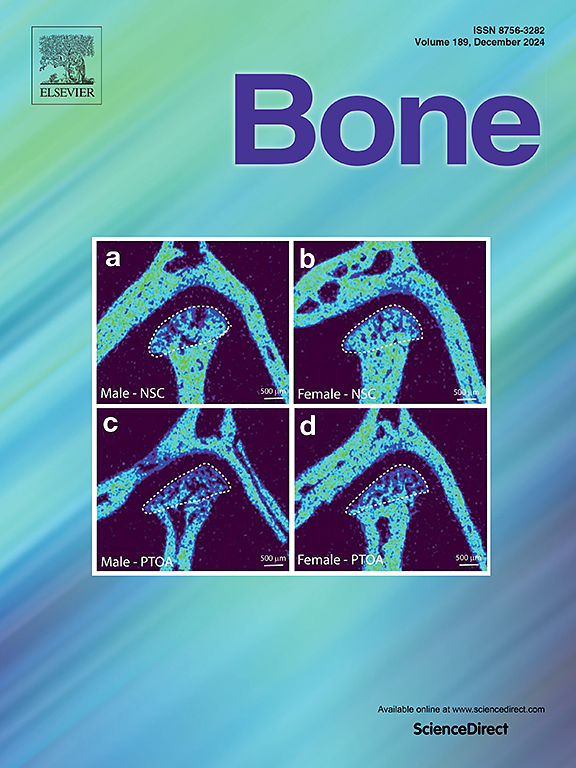Assessing bone mineral density and cortical geometry using high-resolution peripheral quantitative computed tomography in pediatric survivors of high-risk neuroblastoma with severe growth failure
IF 3.6
2区 医学
Q2 ENDOCRINOLOGY & METABOLISM
引用次数: 0
Abstract
Introduction
Survival of children with high-risk neuroblastoma (HR-NBL) has increased with multimodal therapy. cis-Retinoic acid (cis-RA), cornerstone of HR-NBL therapy, can cause osteoporosis and premature physeal closure. This study utilized high-resolution peripheral quantitative computed tomography (HR-pQCT), for 3D measures of volumetric bone mineral density (BMD) and microarchitecture, to assess impact of HR-NBL therapy on skeletal structure.
Methods
We prospectively enrolled 20 HR-NBL survivors and 20 age-, sex-, and race-matched healthy reference participants. We assessed leg lean mass adjusted for leg length by DXA and strength using a Biodex dynamometer. Tibia bone microarchitecture was assessed via HR-pQCT scans at 4 % of tibia length and a cortical site at 30 %. We compared tibia length (cm), cortical and trabecular vBMD (mg HA/cm3), geometric and structural parameters between groups. Linear regression models assessed group differences in bone microarchitecture adjusted for leg lean mass.
Results
Compared to reference participants, tibia length was significantly shorter in HR-NBL survivors (31.6 cm [27.7,39.5] vs. 36.1 cm [30.4,40], p < 0.005), consistent with significantly lower height Z-score in the HR-NBL cohort (p < 0.001). HR-NBL survivors demonstrated lower cortical area (178.3mm2 [121.9273.5] vs. 214.6mm2 [159.4326.9], p < 0.05) and cortical perimeter (60.0 mm [51.9,82.5] vs. 68.8 mm [57.7,90.8], p < 0.01). After adjusting for tibia length, these differences were no longer significant. Total, cortical, and trabecular volumetric BMD, were not significantly different between groups. Cortical geometry and peak torque deficits were associated with muscle deficits when adjusted for leg lean mass (p < 0.001).
Conclusion
Bone density was not severely impacted in HR-NBL survivors. Muscle deficits persisted years after treatment and underscored cortical geometry deficits.
使用高分辨率外围定量计算机断层扫描评估患有严重生长衰竭的高危神经母细胞瘤儿童幸存者的骨矿物质密度和皮质几何形状
多模式治疗增加了高危神经母细胞瘤(HR-NBL)患儿的生存率。顺式维甲酸(顺式ra)是HR-NBL治疗的基石,可导致骨质疏松和骨骺过早闭合。本研究利用高分辨率外周定量计算机断层扫描(HR-pQCT),对体积骨矿物质密度(BMD)和微结构进行三维测量,以评估HR-NBL治疗对骨骼结构的影响。方法前瞻性地招募了20名HR-NBL幸存者和20名年龄、性别和种族匹配的健康对照受试者。我们通过DXA评估腿长调整后的腿瘦质量,并使用Biodex测力仪评估力量。通过HR-pQCT扫描在胫骨长度的4%和皮质部位的30%评估胫骨骨微结构。我们比较两组胫骨长度(cm)、皮质和小梁vBMD (mg HA/cm3)、几何和结构参数。线性回归模型评估了根据腿瘦质量调整后的骨微结构组间差异。结果与对照受试者相比,HR-NBL幸存者的胫骨长度明显缩短(31.6 cm [27.7,39.5] vs. 36.1 cm [30.4,40], p <;0.005),与HR-NBL队列中显著较低的身高z得分一致(p <;0.001)。HR-NBL幸存者表现出较低的皮质面积(178.3mm2 [121.9273.5] vs. 214.6mm2 [159.4326.9], p <;0.05)和皮质周长(60.0 mm [51.9,82.5] vs. 68.8 mm [57.7,90.8], p <;0.01)。调整胫骨长度后,这些差异不再显著。总骨密度、皮质骨密度和小梁体积骨密度在两组间无显著差异。经腿部瘦质量调整后,皮质几何形状和峰值扭矩缺陷与肌肉缺陷相关(p <;0.001)。结论HR-NBL患者骨密度未受严重影响。肌肉缺陷在治疗后持续数年,并强调皮质几何缺陷。
本文章由计算机程序翻译,如有差异,请以英文原文为准。
求助全文
约1分钟内获得全文
求助全文
来源期刊

Bone
医学-内分泌学与代谢
CiteScore
8.90
自引率
4.90%
发文量
264
审稿时长
30 days
期刊介绍:
BONE is an interdisciplinary forum for the rapid publication of original articles and reviews on basic, translational, and clinical aspects of bone and mineral metabolism. The Journal also encourages submissions related to interactions of bone with other organ systems, including cartilage, endocrine, muscle, fat, neural, vascular, gastrointestinal, hematopoietic, and immune systems. Particular attention is placed on the application of experimental studies to clinical practice.
 求助内容:
求助内容: 应助结果提醒方式:
应助结果提醒方式:


